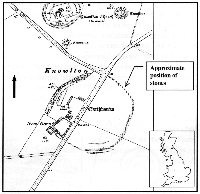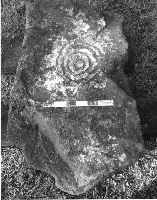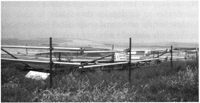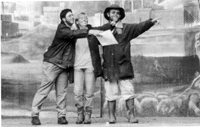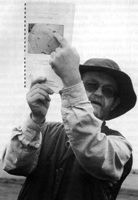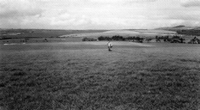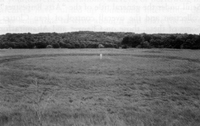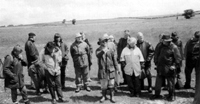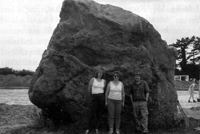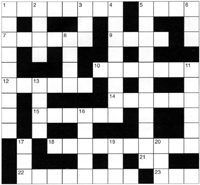|
|
|
|
A
Decorated Megalith from Knowlton Henges, Dorset, England
|
|
As many of you will already know, sadly Sara Champion died peacefully
on Sunday 14th May 2000 after a long battle with cancer. PAST
does not normally include obituaries, but it would be strange indeed
not to include a tribute here to an editor who was responsible for PAST
from July 1997 and who continued her role despite her illness. She will
be greatly missed at Council Meetings of the Society and will be fondly
remembered for her contribution to archaeology and the manner in which
she made that contribution; learned but accessible and with a clear
sense that prehistory was fun. Sara was an avid user of new technology,
bringing her experience in this medium into PAST and encouraging
Society members to surf the net themselves via her very successful column
'Champion's choice'. Linda Hurcombe
|
|
It
is my very great honour and privilege to be able to say some words about
dear Sara and her life. This, in itself, is slightly daunting as Sara
always seemed to be living many lives at the same time. That isn't to
say the lives were separate - quite the opposite because as we know
the various strands all intertwined as parts of a glorious action-packed
whole. There was a "family life" as a loving and greatly loved wife
and mother; as a dear daughter and sister; or as a rather exciting aunt
- "Aunty Mud" as she was affectionately called. There was her "professional
life" as a valued and highly respected work colleague, organiser, teacher
or tutor. Then, too, a 'social life' as a great party giver, an enthusiastic
cook, a bon-viveur, a disc-jockey, a sports fan, a chorister and so
on. Whatever the activity and setting, Sara herself was always the same
- in the centre of things, open, friendly, generous, lovable - someone
with a passion for everything life has to offer. Alexander Campbell
|
|
THE GHOST OF A PAST ANTIQUARIAN
|
|
| On May 29th 2000
an early archaeological investigation reminded the interested world of
its presence. The vertical shaft dug in 1776 through Silbury Hill by Cornish
Miners in the employ of the Duke of Northumberland collapsed, leaving
a gaping hole and a big headache for the site managers. What seems likely
is that the traditional capping of the shaft finally gave way and fell
into the void below. Inevitable questions are where did they dump all
the rest of the spoil and is some of the Hill's current shape due to eighteenth
century failure to restore? The immediate action was to make all safe and the Hill currently sports a lid of scaffolding and planking, plus security guards, extra fencing and a plethora of notices. The public have in general respected the requests to stay away and the vegetation on the Hill has benefited enormously from the rest it has been given. The Hill's metallic hat did attract other attention - a reported 22 hits by lightening during a thunderstorm. |
|
|
After survey and recording it is likely that the chasm will be infilled with chalk. It is a slightly scary thought that I was excavating very close to the top of the shaft in 1970 and underneath it in 1969 though we had mining rings and planks in the tunnel and anyway I was relegated to the ditch most of the time!). Even quirkier is that the collapse happened on the day the Avebury World Heritage Site Officer got married. Is there something in this? Gill Swanton
|
|
|
FURTHER
COMMENTS ON PALAEOLITHIC ART
|
|
|
I am grateful
to Paul Bahn for setting me right in PAST about the editions in English
of Max Bégouën's 1925 novel on Palaeolithic art, Bison d'Argile. However
it does not seem to me to be important that the Abbé Henri Breuil did
not publish his very short note in the Comptes rendus de I'Academie
des Inscriptions on what he described as the 'Homme masqué en
Bison jouant de la flûte (?), précéde d'un animal fantastique femelle'
until 19 September 1930. In the first paragraph he acknowledges the
assistance of 'le comte Bégouën et ses fils' in the 'travail de dechiffrement'
of the detail of the 'innombrables gravures' Max Bégouën's comments
to me on the orientation of the masked figure were made I think in August
1974 during the second of the two occasions when I visited the cave
in his company and it was in the context of his remarks on the subject
of the orientation of the human figures that a copy of the American
edition was lent me to read. Michael Eastham Dolau, Dwrbach, Fishguard, Pembrokeshire, SA65 9RN
|
|
RECYCLING RESOURCES, REMOVING RESOURCES A REVIEW OF "TALKING RUBBISH"
|
|
|
The flyer for the
one day conference organised by the Prehistoric Society at the Institute
of Archaeology, London boded well I thought for the airing of new ideas
in the field of structured deposition and accumulations. Cynthia Poole
|
|
|
THE
PREHISTORIC LANDSCAPE AND MONUMENTS OF CRANBORNE CHASE
|
| Maria and I arrived
at Dillington at about 6.00 pm on Friday. The grounds are beautiful and
our room very comfortable. After the sherry reception and a very good
meal, we went to the theatre! Proceedings began with a minute's silence
in memory of Sara Champion. Bob Bewley, in almost his last official engagement,
then introduced Prof. Richard Bradley who delivered an excellent introduction
to the weekend, reminding us all of the works of Pitt-Rivers and the Cranborne
Chase Project of the late 1970s early 1980s and introducing the new campaign
of work. My knowledge of archaeology is virtually non-existent but I felt
that I understood what was said (or at least most of it). We went back
to the bar for a nightcap or several and retired to a comfortable bed. The next morning after an excellent breakfast we embarked on an intensive morning of 'scene setting' lectures by Martin Green, Mike Allen, Julie Gardiner, Clive Ruggles and a rather poorly Mark Corney (flu not an excess of alcohol on this occasion). All the lectures were very informative and never boring. We boarded our coach at 12.30 pm for an afternoon 'In the General's footsteps' and drove to the Knowlton Circle complex, where we were joined by John Gale, who explained the layout of the monuments and told us about Bournemouth University's recent excavations. Charly French and Helen Lewis took a break from a huge augering programme in the Allen Valley to explain the current campaign of environmental work. |
| On then to Oakley
Down and Rushmore Park. We spent long enough, but not too long, at each
site, first with Martin Green, aloft a sizeable barrow, explaining the
layout of the Oakley Down cemetery and pointing out other famous landmarks
such as Wor Barrow and the Ackling Dyke. Richard Bradley and Julie Gardiner
demonstrated the relationship between the South Lodge Middle Bronze Age
settlement and its associated barrow cemetery and field system and raised
some laughs with a few excavation anecdotes. My enthusiasm for the subject
matter was growing apace - along with the awareness of my ignorance. We
drove to Dorchester then for a well-eamed glass of wine (and all the scrumptious
tea and cakes we had forgotten all about stopping to eat during the afternoon)
and a look round the County Museum at the generous invitation of Pete
Woodward. Dorchester is a very well presented local museum which seems
to have enough funds to buy local material and keep it out of the hands
of the big national collections. Back on the coach and, after another
excellent dinner at Dillington, we wound down to a late evening talk by
Martin, whose farm we would be visiting the next day, about the ecology
of the farm and the set-aside and Countryside Stewardship arrangements
that allow him to indulge in so much excavation and fieldwork. Another
night cap (or two) was followed by bed. |
| The following
morning we disembarked in a brief heavy shower of hail at Down Farm, where
we were given a guided tour and a chance to look at Martin's extraordinary
private museum. We visited the pair of henge monuments and Grooved Ware
buildings on Wyke Down where Mike and Martin explained both the archaeology
of the site and showed us the effects of just a few years' of weathering
on the ditches and the types of plants and animals (especially snails
of course) that had started to colonise its different features. Charly
and Helen joined us again to talk about last year's barrow excavations
in the adjacent field. Richard and Clive then talked about the Dorset
Cursus, though we could not see much of it because of the state of the
crops and long grass, and pointed out the relevant vistas. Martin had
thoughtfully rotivated along the line of one of the ditches so we ceremonially
processed to the nearby Pleistocene river cliff, scene of excavations
in 1984, from where we could view the unique (for this area) periglacial
naleds in the fields below. |
|
We then had the
opportunity to peer down the huge Mesolithic shaft in Fir Tree Field
and marvel at its size - it has now weathered considerably and was half
full of water but is still very impressive. We were reminded of the
fate of the unfortunate prehistoric deer who fell into the shaft by
the sight of an ex-rabbit who had recently suffered a similar demise.
Over lunch. as there were too many of us to all get in at once, we filtered
through Martin's museum, which is packed with material from the surrounding
area. Ros Cleal and Julie were on hand to explain and demonstrate individual
pots and flint artefacts and to answer questions. |
|
My impression is that everybody thoroughly enjoyed the weekend and we were all impressed by the way we were kept to the timetable. I would like to thank Julie, Mike and Martin for organising everything so efficiently and producing the excellent guide to help us get the most out of the weekend. We were very grateful to Wayne Bennett and the staff at Dillington House for their courtesy and efficiency. I am looking forward to reading Martin's book when it comes out later this year and shall persuade Maria that we ought to book the next Prehistoric Society study weekend at Dillington (hillforts next I hear!). Robert Mayall
|
|
Rouffignac: Le Sanctuaire des Mammouths by Jean Plassard. Paris. Editions du Seuil. 99 pp ISBN 2 02 034402 5 Price: 230FF.
|
|
|
This is the latest
in a series of large format books on Palaeolithic rock art which have
been published by Seuil under the general title of the "Arts Rupestres
" collection and the overall control of Jean Clottes. Some of these,
those on Chauvet and Altamira for example, have been translated into
English and are distributed by Thames & Hudson; others such as the book
on Niaux and this one are, as yet, only available in French.
Two things are
remarkable about this. the first is the depth of feeling inherent in
this passage and the second, which shows where I stand on the issue,
is my sense of surprise that doubt still exists about the works at Rouffignac.
Here is not the place to rehearse all the arguments about this, but
two observations, one about Daniei's comments and one about Bahn's,
might be pertinent.
"Contrary to the often repeated claims (eg Nougier & Robert 1957) that the 'paintings' of Rouffignac were first mentioned by Frangois de Belleforest in a publication of 1575, and occasionally by later authors, there is not a single mention by anyone of drawings in that cave before the mid-twentieth century." It is important
to point out, therefore, and possibly Plassard is unaware of this, that
in the later revision of this book (Bahn & Vertut, 1997) Bahn says "Rouffignac
is undoubtedly a genuine Palaeolithic decorated cave, and most of the
art in its miles of galleries is unquestionably authentic." However,
he also called for analysis and/or dating of pigment of "these few specific
images in that cave over which, rightly or wrongly, a question mark
still hangs." Unfortunately unless everything could be dated, an obvious
impossibility, this would not stop a sceptic from saying 'Okay that
one is acceptable but what about this one?' and even Daniel admitted
that some of the material might be genuine. And it seems that dating
is not possible; work which has been done on the pigments used in the
cave has shown that the material, as with much cave art, does not contain
dateable carbon. This is stated by Plassard (p.25) and confirmed by
Jean Clottes (1998). References:
|
|
|
|
|
| It will come as no surprise to anyone who knew Sara Champion that several people offered to continue the editorial role she so ably fulfilled and that all of them would be needed to cover and develop the work. Dr Linda Hurcombe will act as editor and her address (see page 1) will be used for correspondence, but Dr Josh Pollard and Gill Swanton will also form part of the editorial team. We are all keen to develop PAST and ensure that it serves Prehistoric Society members well. We have already had a short meeting to brainstorm some new ideas and will be outlining these in more detail in future editions of PAST. At this point we would appreciate any suggestions from members of things they would like to see in the newsletter and comments on the format(s) appropriate for conveying the information. Please post or e-mail your ideas to Linda or buttonhole any of us in person. | |
|
DON'T KEEP THAT GOOD NEWS TO YOURSELF! Summer is always
a busy time for archaeologists but if your travels, excavations, surveys,
or burrowing in archives have turned up something interesting, do take
some time to write about it and share the news with the circa 2000 other
members. (Photos welcome!)
|
|
|
|
|
| PAST
recently advertised a set of PPS volumes for sale, this time we
have a plea for help in filling the gaps in their collection. Spencer
Carter needs copies for 1963. 1960, 1940 Pt2, 1939 Pt1. If you can help
please contact Spencer Carter +44 (0)7774-860-341.
|
|
|
|
|
NB Most of the words are taken from volume 65 of PPS - the source page is given in square brackets. How many can you track down? R. John Cruse |
|
| Across 1 & 5 [315] "Recent studies reveal that, occasionally, the production of a ........ .... begins with a large biface" (8,4) 7 [269] "At the same time, rich '......-type' burials and the emergence of 'oppida' types of settlements demonstrate a similar southern shift (6) 9 [-] Thin piece cut from wood or broken from stone (4) 10 [467] "At this same meeting, the 24 year old Grahame Clark was first elected to the Society's ......." (7) 12 [-] ......, Saxons and Jutes (6) 14 [-] Next planet beyond Saturn (6) 15 [183] "Stjernquist's work at the Late Bronze Age grave fields of ......" (6) 18 [11] "He felt the growth in .......... was a vindication of his radical proposal in 1850 that there had been a pre-Celtic race in Britain" (10) 21 [-] Unit of width in printing (2) 22 [333] "Instead, the ........ period may be regarded as essentially contemporary with the southern Greek FN" (8) 23 [359] Zone RDBL contained 1-3% of ... and pine (3)
|
Down
|
|
There are lots of conference coming up just after you receive this copy of PAST. Some have also included flyers so there is no excuse if you were wondering how to make a booking. Few new conferences have sent information to us, but for those of you who like a bit of theory with your prehistory there is of course the TAG conference shortly before Christmas, which is to be held at Oxford this year. Lithic Studies in the year 2000: 8.9.00-11.9.00 tel 02920 573274
British Association of Biological Anthropology
and Osteoarchaeology: 1.9.00-3.9.00 tel: 01274 233545
European Association of Archaeologists: 10.9.00-17.9.00
|
|||||||||
| |
The Prehistoric Society Home Page |
